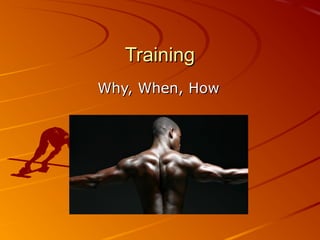
Priciples and methods of training
- 2. Why Do People Train? For a specific sport To manage weight Improve general fitness Recover from injury Muscular development Social, physical, mental reasons
- 3. How to Design an Exercise Programme 1. Have a Goal or Aim 2. Decide on a Training Method 3. Apply the Principles of Training 4. Plan the Training Session
- 4. Training Threshold This is the MINIMUM amount of training or exercise that must be undertaken to make a significant difference. As your body adapts to training and you get fitter, the training threshold will increase. Training Threshold can be determined and monitored by measuring your heart rate. (Heart Rate should be above 60% of Max Heart Rate).
- 5. The Principles of Training Specificity Progression Overload Reversibility Tedium SPORT
- 6. Specificity Training needs to be SPECIFIC to the individual, the aim of the programme, the muscles used, the skills required, the energy system used etc Eg……
- 7. Progression The amount of exercise and the amount of stress you put on you body must be gradually increased. Increased must be realistic, but significant. No increased = No improvement. Increase to big = Unachievable and demotivated
- 8. Overload Overloading your body with higher work rates will increase the demand placed on the body. This will improve fitness.
- 9. Overload Overload can be increased in 3 ways 1. Increasing Frequency – How Often 2.Increasing Intensity – How Hard 3.Increasing Duration – How Long
- 10. Reversibility Fitness levels will deteriorate rapidy if you stop training. It only takes 3 / 4 weeks to get out of condition. Training must be sustained.
- 11. Tedium If training is boring, you are less likely to continue. Training should be fun and varied.
- 12. The FITT Principle Frequency – How Often - at least 3 x a week. - eg every other day to allow recovery Intensity- How Hard - monitor heart rate - keep above training threshold Time – How Long - Minimum of 20 mins per session Type – What Kind - Training method
- 13. Training Methods Continuous Training Fartlek Training Interval Training Weight Training Circuit Training
- 14. Continuous Training No rest periods Aerobic Steady pace Training must be within heart rate zone (60%-80% of max heart rate) Eg running, cycling, rowing, aerobics
- 15. Fartlek Training Speed Play Continuous training that varies the intensity. Aerobic exercise with short bursts of anaerobic Running is most popular.
- 16. Interval Training Alternate periods of work and rest. Long work periods need long rest, short work periods need shorter rests. Eg. On 100m track Sprint 100m, walk 300m. Repeat several times.
- 17. Weight Training A heavy weight lifted a few times will increase your maximum strength. A light weight lifted repeatedly will increase your dynamic strength / muscular endurance. A medium weight moved quickly will increase your explosive strength / power.
- 18. Weight Training Repetitions (Reps) Eg How many times you lift Bench Press the weights. 15 x 20kg (15 Reps) Repeat 3 times (3 Sets) Sets How many reps you perform.
- 19. Circuit Training 8 – 15 stations arranged in a loop. Different exercise completed at each station.
- 20. Circuit Training Ways to complete the Ways to progress the circuit. circuit. Do a number of reps at Do more reps at each each station. station. Spend an amount of time Increase time spent on at each station eg 30 secs. each station. Short rests may be Reduce rest time between included between stations. stations. Repeat circuit. Make activities more challenging eg raise height of step if doing step ups.
- 21. Continuous Training Advantages Disadvantages Good for aerobic Can be boring. fitness. Not good for No specialist anaerobic or speed equipment needed. training. Good for fat burning.
- 22. Fartlek Training Advantages Disadvantages Trains aerobic and Difficult to measure anaerobic systems. training. Good for games Needs self which have discipline to changes of pace. maintain work rate. No specialist Not sport specific. equipment.
- 23. Interval Training Advantages Disadvantages Used for aerobic and Hard to keep going. anaerobic or mixture Can be repetitive and of both. boring. Easy to measure workload. Suitable for lots of sports. Times and distances can be varies to suit individuals.
- 24. Weight Training Advantages Disadvantages Can target specific Needs specialist muscle groups equipment which can Used for most sports be exspensive. Effect way of Needs special location increasing muscular to be used safely. strength and Needs to be well endurance. planned with correct Progression can be techniques. easily measured. Not suitable for U16
- 25. Circuit Training Advantages Disadvantages Lots of activities can be Needs organisation and included. Which helps planning. motivation. Can take time to set up. Can be designed to be specific to any sport. Can be adapted to include fitness and skill work. Does not require specialist equipment. Can train both aerobic and anaerobic.